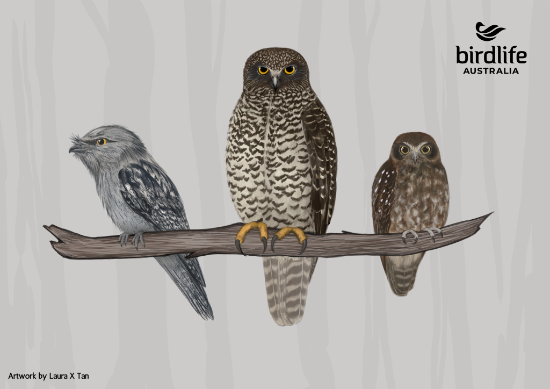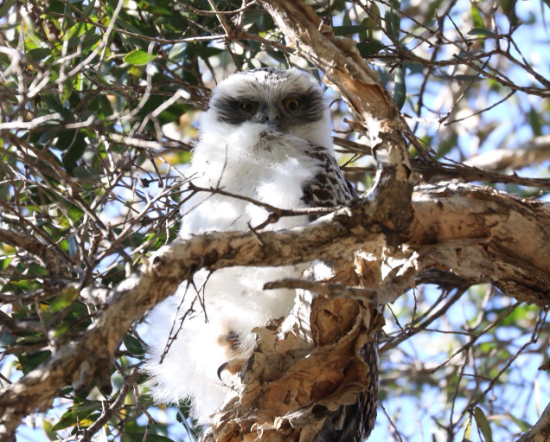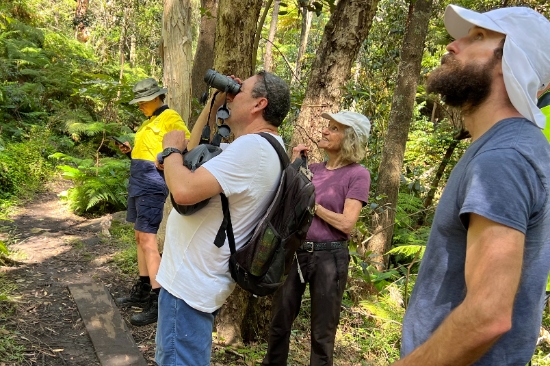Powerful Owls
Wooo Hooo - Powerful Owls Calling
April is a good time to hear Powerful Owls as they are entering the breeding season and will often call just before dawn and just after dusk. Read on to learn more about how you can identify their call and how you can help protect them.
Local citizen science volunteers Neil and Sandy, from Birdlife Australia’s Powerful Owls project would love to know where you’re hearing and seeing these owls locally.
If you see or hear a Powerful Owl email powerfulowl@birdlife.org.au to record your discovery. Please include the following information:
- Your location
- Time of observation
- Type of observation - did you see and/or hear the owl?
- Other details you may have noted eg. call heard, roosting pair sighted, juvenile with parents sighted, seen flying into hollow, etc.
- Attach an image if you have one.

The illustration above compares a Powerful Owl in the centre, Tawny Frogmouth to the left and Southern Boobook to the right.
The Powerful Owl is Australia’s largest owl, standing around 60cm tall from head to tail with a wingspan of around 140 – 150cm. They have brown v-shaped chevrons on their front, large yellow feet and yellow eyes. Owlets (juveniles) are fluffy with white feathers on their fronts and heads and stripy grey-brown and white on their backs.
What call does the Powerful Owl make?
Listen out for a deep, slow ‘woo-hoo’ call. These owls also make a few other sounds including soft bleating calls and growls. Young birds make high-pitched trills.
To check if it’s a Powerful Owl you’re hearing, listen to this recording from Wild Ambience of owls interacting.
Make sure you’re not confusing this owl with the more common Boobook Owl.
Where are they found?
In urban areas Powerful Owls may be found near creeks and waterways that link patches of remnant bushland and mature gardens with large trees. Locally they’ve been spotted in some of our bushland reserves including Parsley Bay and Cooper Park. They have also been seen nearby in the Botanic Gardens and Centennial Park.
Throughout the night the owls will move through reserves, golf courses and backyards to hunt and defend their territory. They usually return to a number of regular roosting (resting) spots, sometimes on the exact same branch. They choose roosts that protect them from being mobbed by aggressive daytime birds such as the Noisy Miner and Pied Currawong.
What do they eat?
Possums are the main prey of these owls, however they also eat flying foxes, gliders, birds, rats, rabbits, beetles and the occasional cat.
Powerful Owls catch their prey using their feet that have large talons. Then they use their hooked beaks to tear it into pieces small enough to swallow. Some of the feathers or fur are removed first, and also the intestines. These may be found on the ground below branches where the owl was perched.
When do they breed?
Powerful Owls generally mate for life. They start looking for suitable trees for nesting from late March and lay their eggs in deep hollows around May to June. The eggs hatch after about five weeks and the young owlets will usually fledge from the nest around August to October. Young birds remain with their parents for several months after fledging and may stay within their parents’ territory for over a year.

Powerful Owlet - Renee Ferster Levy
Why are they a listed threatened species?
Life in the city can be hard for Powerful Owls. They face the loss of breeding and roost trees, competition for tree hollows, car strike, electrocution and other threats such as artificial night lighting. They can also be killed by poison found in rats and mice they eat.
Land clearing and removal of hollow-bearing trees is a particular threat as this reduces the availability of nesting trees. The hollows used for nesting need to be at least 50-60cm across. Trees need to be at least 150-200 years old for a hollow of this size to form.
As our urban bushland becomes more fragmented movement for owls becomes harder. This is particularly challenging for young owls who can end up in trouble as they try to move away from home to find their own territory.
They are also very susceptible to disturbance from humans and other birds.

What can we do to help protect them?
The Powerful Owl Project from Birdlife Australia is monitoring owls around Sydney to help understand their behaviour in our urban bushland and protect them. Local volunteers in our area are keen to hear about any birds you’ve spotted or heard calling.
- If you see a Powerful Owl email powerfulowl@birdlife.org.au (include details noted at the top of this article).
- Keep your dog on a leash when walking through bushland areas
- Keep your cat contained within your property
- Plant native trees and shrubs in your backyard
- Avoid clearing remnant bushland
- Protect large hollow-bearing trees
- Try not to disturb nesting and roosting owls and avoid flash photography day or night
- Avoid using Second Generation Anticoagulant Rodenticides as these poisons cause secondary poisoning of non-target native species (follow this link for more information)
Want to learn more about local wildlife and native plants?